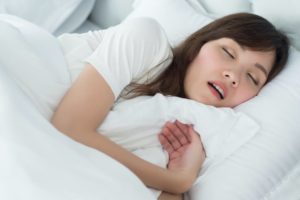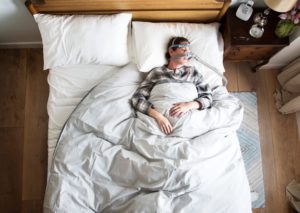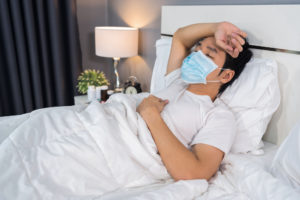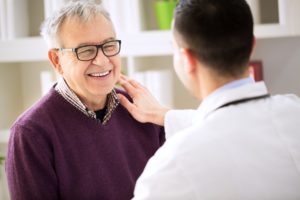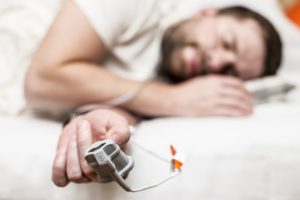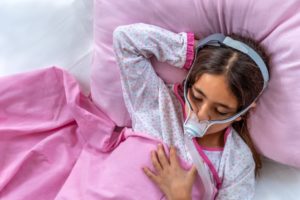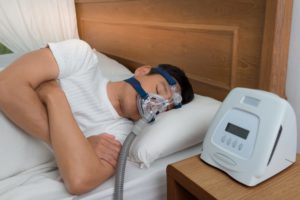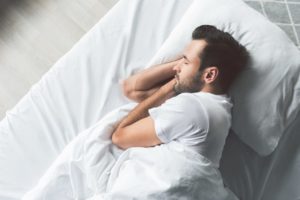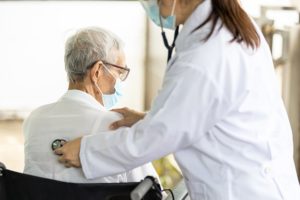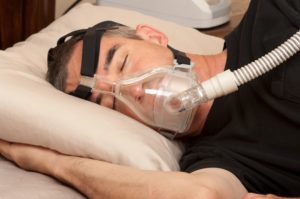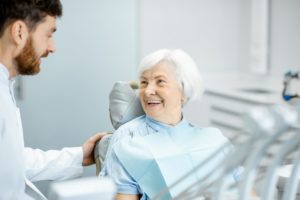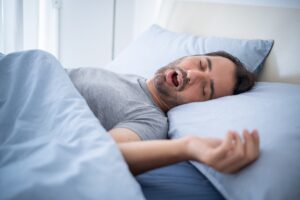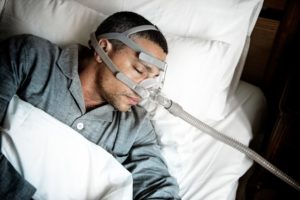When you buy through our links, we may earn a commission. Products or services may be offered by an affiliated entity. Learn more.
What Causes Sleep Apnea?
What causes or contributes to the development of sleep apnea depends on the type of sleep apnea a person has. Obstructive sleep apnea (OSA) occurs commonly, with between 10% and 30% of U.S. adults estimated to have the disorder. Central sleep apnea (CSA) is a much less common disorder that affects less than 1% of adults.
Both OSA and CSA are sleep-related breathing disorders that involve excessive instances of slowed or stopped breathing during sleep. We highlight the causes and risk factors for each of these sleep disorders and describe symptoms that signal the need to talk to a doctor.
Obstructive Sleep Apnea Causes and Symptoms
Obstructive sleep apnea is caused by a physical blockage in the airway that repeatedly slows or stops breathing during sleep. It is normal for space in the airway to be reduced as tissues in the mouth and throat relax during sleep , but in people at risk of OSA these changes can cause the airway to become partially or completely obstructed.
People who have OSA may be asymptomatic or experience symptoms such as:
- Daytime sleepiness
- Falling asleep easily in unstimulating situations
- Snoring or gasping while asleep
- Headaches upon waking
- Waking during the night to urinate
Understand Your Sleep Apnea Risk
Answer three questions to take charge of troubled sleep.
Central Sleep Apnea Causes and Symptoms
In central sleep apnea, lapses in breathing during sleep are caused by a communication failure between the brain and the muscles that control breathing. Most people who have CSA develop the disorder as a result of an underlying health condition, but in rare cases, it is a disorder that occurs on its own.
CSA is often asymptomatic . When symptoms do occur, they may be similar to those of obstructive sleep apnea. Symptoms of CSA may include:
- Daytime sleepiness
- Poor sleep quality
- Trouble falling or staying asleep
- Difficulty concentrating
- Being awakened from sleep by shortness of breath
- Morning headaches
- Nighttime chest pain
Risk Factors for Obstructive Sleep Apnea
Researchers have found that several factors can increase a person’s risk of developing obstructive sleep apnea.
Older Age
Although OSA can occur at any age, the disorder becomes more common as people grow older. Recent research suggests that older adults may be more prone to developing OSA due to physical changes that make the airway more likely to collapse during sleep.
Male Sex
Males are two to three times more likely to be diagnosed with OSA. The risk in females increases once they begin the menopausal transition.
Hormones likely contribute to these differences , with testosterone increasing the risk of developing OSA and estrogen and progesterone reducing the risk. As a result, transgender individuals who have gender-affirming hormone therapy may have their OSA risk altered.
Obesity
The greater a person’s body weight is relative to their height, the more likely they are to develop OSA. In fact, one study found that each 10% increase in body weight corresponds to a person being six times more likely to have OSA.
Experts estimate that around 60% of people with moderate and severe OSA developed the disorder as a result of having obesity. Other bodily measures, like neck size and waist size, can also affect the risk of OSA. For example, a neck measuring more than 16 to 17 inches is associated with greater OSA risk.
Physical Features
Since OSA involves the airway becoming obstructed during sleep, any physical features that narrow the airway can increase a person’s chance of having the disorder. Features that may increase the risk of OSA include:
- A lower jaw set far back
- A small lower jaw, called micrognathia
- Excessive tissue in the throat
- A large tongue
- Enlarged tonsils or adenoids
- A deviated septum
Smoking
People who smoke may also face a higher risk of developing OSA. While this link is less clearly established, one study found that people who currently smoke have OSA at rates three times higher than those who do not currently smoke.
Family History
A person with a family history of OSA or snoring is more likely to develop OSA themselves. Researchers believe some people may be more likely to have OSA because of the way their genetics influence the shape of their face and skull. However, some of the tendency to develop OSA among family members could also be the result of having similar lifestyles or living in a shared environment.
Nasal Congestion
Nasal congestion, commonly called a stuffy nose, from any cause has been found to make a person twice as likely to develop OSA compared to those without congestion. That said, treating nasal congestion does not always relieve the symptoms of OSA.
Nasal congestion may result from allergies, but people without allergies can also have a stuffy nose. Nasal congestion can also be caused by an infection, pregnancy, exposure to irritants in the air, drinking alcohol, and using certain medications or substances. In some people, nasal congestion can be triggered by temperature changes, spicy foods, or exposure to perfume, smoke, or cleaning products.
Health Conditions
OSA occurs more often in people with certain health conditions, including:
- Congestive heart failure
- High blood pressure
- Asthma
- End-stage kidney disease
- Chronic obstructive pulmonary disease (COPD)
- Stroke
- Hypothyroidism
- Parkinson’s disease
Pregnancy
OSA occurs more commonly during pregnancy. If a person only has OSA during pregnancy and not at other times, it may be referred to as gestational OSA. Research suggests that OSA occurs more frequently during the third trimester of pregnancy than earlier on.
When someone is pregnant, their throat and nasal passages may become more narrow. Multiple factors may explain these changes, including the distribution of body fluids during pregnancy as well as increases in blood volume and more frequent nasal congestion. Shifting hormones during pregnancy may also affect breathing patterns and the risk of OSA.

Risk Factors for Central Sleep Apnea
Research has identified a variety of risk factors that can increase the likelihood of developing one of several types of central sleep apnea.
Older Age
Adults over age 65 have been found to experience CSA at a higher rate than younger adults. This difference may be because CSA often stems from underlying health issues, like heart failure, that are more common in older adults. There may also be other aspects of the aging process that make CSA more likely to occur as a person gets older.
Male Sex
As with OSA, people assigned male at birth are more likely to develop CSA than those assigned female at birth. Experts suspect that hormones may drive this difference, as increased testosterone levels are associated with a greater susceptibility to central sleep apnea.
Heart Failure
Studies suggest that up to 50% of people with heart failure experience OSA, CSA, or both disorders. While the exact reason why heart failure causes CSA is unknown, it may stem from lower levels of carbon dioxide in the blood that can develop in people with heart failure.
Stroke
Research has found that in the first few days after experiencing a stroke, about 70% of people can develop central sleep apnea. However, CSA may resolve after a stroke on its own, as only 7% of people have CSA three months after a stroke.
Sleep apnea can develop regardless of where in the brain the stroke occurred, though disordered breathing during sleep may be more severe if the stroke happened during sleep.
Other Health Conditions
In addition to heart failure and stroke, other health conditions associated with CSA include:
- Kidney failure
- Atrial fibrillation
- Certain types of paralysis
Altitude
As a person moves to a higher elevation, their risk of CSA increases. In fact, nearly 25% of people develop CSA around 8,200 feet in elevation, while almost everyone will develop this breathing disorder if they reach over 13,100 feet in elevation. Symptoms may be most severe on the first night after reaching a high altitude environment and may resolve as a person adjusts to the altitude.
Certain Medications
Medications that impact the central nervous system or the body’s ability to respond to low blood oxygen levels can increase the risk of CSA. These medications include:
- Opioids
- Methadone
- Benzodiazepines
- Antidepressants
- Gabapentinoids
It’s important to discuss any concerns about medications and CSA risk before making changes to your dosage. Do not stop taking a prescribed medication without consulting a health professional.
Positive Airway Pressure (PAP) Therapy
CSA develops in 5% to 15% of people who receive a type of treatment for obstructive sleep apnea called positive airway pressure (PAP) therapy. In over half of people who experience this form of CSA, the condition goes away on its own within a few months.
How Sleep Apnea Is Treated
For most people with either OSA or CSA, continuous positive airway pressure (CPAP) therapy is the first recommended treatment. A CPAP machine pushes air through a tube into a mask worn over the nose or nose and mouth. This flow of air helps keep the airway from becoming obstructed during sleep.
If a sleeper cannot tolerate a CPAP machine, their doctor may have them try another type of PAP therapy. Other options include:
- Bilevel positive airway pressure (BiPAP or BPAP)
- Auto-adjusting positive airway pressure (auto-CPAP or APAP)
- Adaptive servo-ventilation (ASV) therapy
These therapies operate similarly to CPAP, with air being delivered to the sleeper from a nearby machine. The best PAP machine for a given person depends on the type of sleep apnea they have and their unique situation.
Additional treatments for OSA that a doctor might consider for some patients consist of:
Doctors often recommend behavior changes, like losing weight, avoiding alcohol or sedative medications, and changing sleep positions along with medical treatment for sleep apnea.
In people with CSA, treatment may focus on addressing the underlying medical condition or medication causing breathing issues. Doctors may also recommend supplemental oxygen during sleep. When PAP therapy and oxygen do not work, certain medications may be used to treat CSA.
When to Talk to Your Doctor
If you are experiencing symptoms of sleep apnea, see a doctor and find out if a sleep study can help find the cause of your sleep issues. Important symptoms to discuss with your doctor include daytime tiredness and frequent awakenings during the night. Also, tell your doctor if someone you live with has noticed that you stop breathing, snore loudly, or gasp while you sleep.

Still have questions? Ask our community!
Join our Sleep Care Community — a trusted hub of sleep health professionals, product specialists, and people just like you. Whether you need expert sleep advice for your insomnia or you’re searching for the perfect mattress, we’ve got you covered. Get personalized guidance from the experts who know sleep best.
References
12 Sources
-
Kline, L. R. (2022, June 1). Clinical presentation and diagnosis of obstructive sleep apnea in adults. In N. Collop (Ed.). UpToDate., Retrieved September 27, 2022, from
https://www.uptodate.com/contents/clinical-presentation-and-diagnosis-of-obstructive-sleep-apnea-in-adults -
Becker, K. (2020, August 25). Central sleep apnea syndromes. Medscape., Retrieved September 27, 2022, from
https://emedicine.medscape.com/article/304967-overview#a6 -
Strohl, K. P. (2021, July 8). Patient education: Sleep apnea in adults (Beyond the basics). In N. Collop (Ed.). UpToDate., Retrieved October 5, 2022, from
https://www.uptodate.com/contents/sleep-apnea-in-adults-beyond-the-basics -
Strohl, K. P. (2022, September). Central sleep apnea. Merck Manual Professional Version., Retrieved October 5, 2022, from
https://www.merckmanuals.com/professional/pulmonary-disorders/sleep-apnea/central-sleep-apnea -
American Academy of Sleep Medicine. (2014). The International Classification of Sleep Disorders – Third Edition (ICSD-3). Darien, IL.
https://aasm.org/ -
Edwards, B. A., Wellman, A., Sands, S. A., Owens, R. L., Eckert, D. J., White, D. P., & Malhotra, A. (2014). Obstructive sleep apnea in older adults is a distinctly different physiological phenotype. Sleep, 37(7), 1227–1236.
https://pubmed.ncbi.nlm.nih.gov/25061251/ -
Peters-Mathews, B., Lee, M., & Sabzpoushan, A. (2020). Blurred binaries: The clinical management of obstructive sleep apnea in transgender patients. Sleep, 43 (Issue Supplement 1), A229.
https://academic.oup.com/sleep/article/43/Supplement_1/A229/5847348 -
Louis, J., & Pien, G. W. (2022, September 22). Obstructive sleep apnea in pregnancy. In V. Berghella & N. Collop (Eds.). UpToDate., Retrieved October 3, 2022, from
https://www.uptodate.com/contents/obstructive-sleep-apnea-in-pregnancy -
Badr, M. S. (2021, September 30). Central sleep apnea: Risk factors, clinical presentation, and diagnosis. In R. D. Chervin (Ed.). UpToDate., Retrieved September 27, 2022, from
https://www.uptodate.com/contents/central-sleep-apnea-risk-factors-clinical-presentation-and-diagnosis -
Malhotra, A., & Fang, J. C. (2021, July 15). Sleep-disordered breathing in heart failure. In M. S. Badr (Ed.). UpToDate., Retrieved October 3, 2022, from
https://www.uptodate.com/contents/sleep-disordered-breathing-in-heart-failure -
Culebras, A. (2022, June 3). Sleep-related breathing disorders and stroke. In M. S. Badr (Ed.). UpToDate., Retrieved October 3, 2022, from
https://www.uptodate.com/contents/sleep-related-breathing-disorders-and-stroke -
Chowdhuri, S., & Parthasarathy, S. (2022, August 11). Treatment-emergent central sleep apnea. In M. S. Badr (Ed.). UpToDate., Retrieved October 4, 2022, from
https://www.uptodate.com/contents/treatment-emergent-central-sleep-apnea





